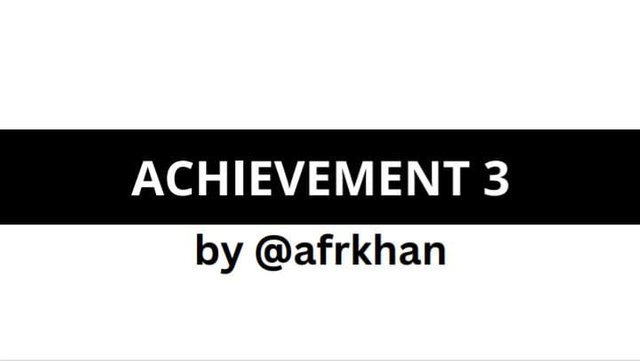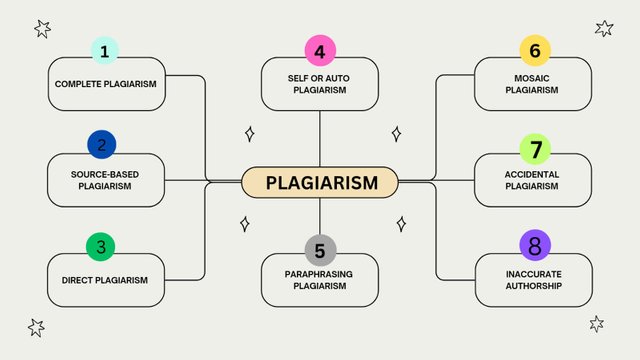Achievement 3 by @afrkhan Task: Content Etiquette
Hello everyone I hope you all are doing well. So today I read about Achievement 3. I am going to share my knowledge about Plagiarism.
What is Plagiarism ?
Definition:
Plagiarism occurs when you copy someone else's work without giving them credit or obtaining their permission.
 Canva
Canva
Explanation:
To understand plagiarism better, imagine someone has put in significant effort, whether it's creating a video, writing a blog, conducting research, producing art, designing graphics, or taking photos. If you use their content in your own work without their permission or proper attribution, this is considered plagiarism.
If someone wants to use another person's content, they must either get permission from the creator or properly credit the original owner. This applies to all types of content, including audio, video, text, images, and more.
Example:
Imagine you are a writer who spends weeks researching and writing a detailed blog post on a specific topic, pouring in your knowledge and expertise. After publishing the post, you start noticing that some other bloggers are using large portions of your content in their own articles, copying your words, ideas, and structure, without giving you any credit or permission.
This is plagiarism, as they have taken your original work and presented it as their own, without acknowledging your authorship.
Types of Plagiarism:
There are many types of plagiarism but I an going to explain the common examples of Plagiarism.
1) Complete Plagiarism.
2) Source Base Plagiarism.
3) Self Plagiarism.
4) Paraphrasing Plagiarism.
5) Mosaic Plagiarism.
6) Accidental Plagiarism.
7) Direct Plagiarism.
8) Inaccurate authorship.
Now, let me explain all these in detail.
1) Complete Plagiarism:
This happens when you copy someone else’s content and present it as your own.
2) Source-based Plagiarism:
This occurs when you use someone else's content but provide an incorrect or inaccurate source/reference.
3) Self-Plagiarism:
Self-plagiarism happens when you reuse your own content in multiple places, like posting the same work across different platforms or communities.
4) Paraphrasing Plagiarism:
This is when you take someone else’s ideas, reword them, and present them as your own. While the wording may change, the idea is still stolen.
5) Mosaic Plagiarism:
This involves blending someone else’s content with your own, often without crediting the original source.
6 ) Accidental Plagiarism:
This happens when you unintentionally use someone else’s work without realizing it, like accidentally copying a paragraph from another source.
7) Direct Plagiarism:
Known as copy-paste plagiarism, this is when you directly copy someone else’s content without making any changes.
8) Inaccurate Authorship:
This type of plagiarism occurs when you falsely claim to be the author of a piece of content, misleading others about the true creator.
I hope this helps to clarify plagiarism and the different ways it can happen. Always remember, if you're using someone else’s work, you need permission or to credit them properly.
My own suggestions for avoiding Plagiarism:
Here are four suggestions to avoid plagiarism:
1. Properly Cite Sources:
Always give credit to the original author when using their ideas, quotes, or research.
2. Paraphrase and Summarize:
When using someone else's work, try to rephrase the information in your own words, but still provide proper attribution. Summarizing large sections of text can also be helpful, as long as you cite the source.
3. Use Own Content:
Create original ideas, research, and writing whenever possible. By relying on your own insights, experiences, and creative work, you ensure that your content is unique and free from plagiarism. Always add your personal touch or analysis to the material you're presenting.
4. Keep Track of Your Sources:
While researching, make a habit of noting down all your sources as you go. This ensures you can easily trace where the information came from and cite it properly when you're writing, reducing the risk of accidental plagiarism.
"I have read and understood the Steemit Etiquette on Steemit Community and will do my best to embrace them"


Es interesante ver como adquieres conocimiento de la plataforma y te esmeras por mejorar cada día.
Ahora, procura enfocarte en compartir en una comunidad y darte a conocer a través de tu contenido. Eso te ayudará a ser más visible en la plataforma.
Felicidades, has llegado a la mejor plataforma donde encontraras personas que aportaran muxhas cosas buenas para tu desenvolvimiento dentro de steemit.